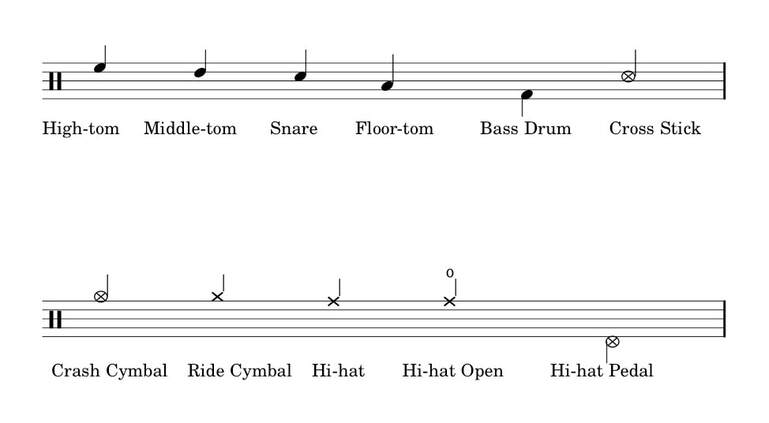Learn here how easy it is to read drum music and how reading can help you to become a better drummer. Once you can read drum music you can learn to play the drum beats to your favourite drum songs right here on drumnuts. Learn the values of the different notes and rests and how they can be combined to form rhythms on the drums. Learn how the different lines and spaces of the music indicate which drums and cymbals to play. Then use your ability to read drum music to learn from drum books and drum charts.
1. Counting the Beat
|
The beat is the foundation of music. It is a drummers job to 'keep the beat' when playing music. When a drummer calls out "1 2 3 4!" at the start of a song he is counting the beat for the other musicians to follow. The beat is the underlying 'pulse' of the music- it should not be confused with the rhythms that we play on the drums. To feel the beat of a piece of music try tapping your foot while you listen to a song you like- most people will naturally tap or clap to the beat of the music
|
3. Notes and Rests
|
The sounds of the drums and cymbals are represented in written music by musical notes. The spaces between the sounds we make on the drums are represented by rests.
|
|
|
5. Time Signatures
|
The Time Signature is a pair of numbers written as a fraction at the beginning of the bar.
It tells us how many beats in the following bar and what note value (see below) is worth one beat. Now we can count the beat as we play drums. The most common time signature is 4/4 |
The top number '4' tells us there are 4 beats or counts in the bar
The bottom number '4' tells us that a quarter note receives one count
The bottom number '4' tells us that a quarter note receives one count
|
|
7. Note Values
|
The table below shows us what some of the different notes and rests look like- some are hollow, some are solid, some have stalks, some have tails. Learn to recognize the different notes, remember their names and how many beats or counts they last for.
|
9. Creating Rhythms
|
On each of the beats of the bar below there are different note values. The different types of notes will sound faster or slower when played next to each other over the even beat of the bar. This is how we can represent rhythms in written music.
On the 1st beat is a Quarter note- this note lasts for one beat. On the 2nd beat are 2 Eighth notes, they last for half a beat so they will sound twice as fast as the Quarter note. On the 3rd beat are 4 Sixteenth notes- they will sound twice as fast as the Eighth notes. On the final beat we return to a single Quarter note. Although the notes change speed because of the different values, the beat remains steady and even: 1, 2, 3, 4. |
|
|
10. Different Drums
|
In written drum music the different lines and spaces of the stave tell us which drum or cymbal to play. If a note is on the top line it tells us to play a different drum than if it is on the bottom line. Below is an example of the positions of the different drums and cymbals on a stave. Some composers will use slight variations. Generally speaking the lower or higher on the stave the note is then the lower or higher on the drum kit it is too- bass drum on the bottom line, crash cymbal at the top etc.
|
11. Parts of the Drum Set
|
Below is a diagram of a standard 5 piece drum set with the generally accepted names of the different drums and cymbals. The 'High Tom' 'Middle Tom' and 'Floor Tom' are sometimes also refered to as 'Tom 1', 'Tom 2' and 'Tom 3' respectively.
The bass drum is also sometimes called the 'Kick Drum'. |
|
|












